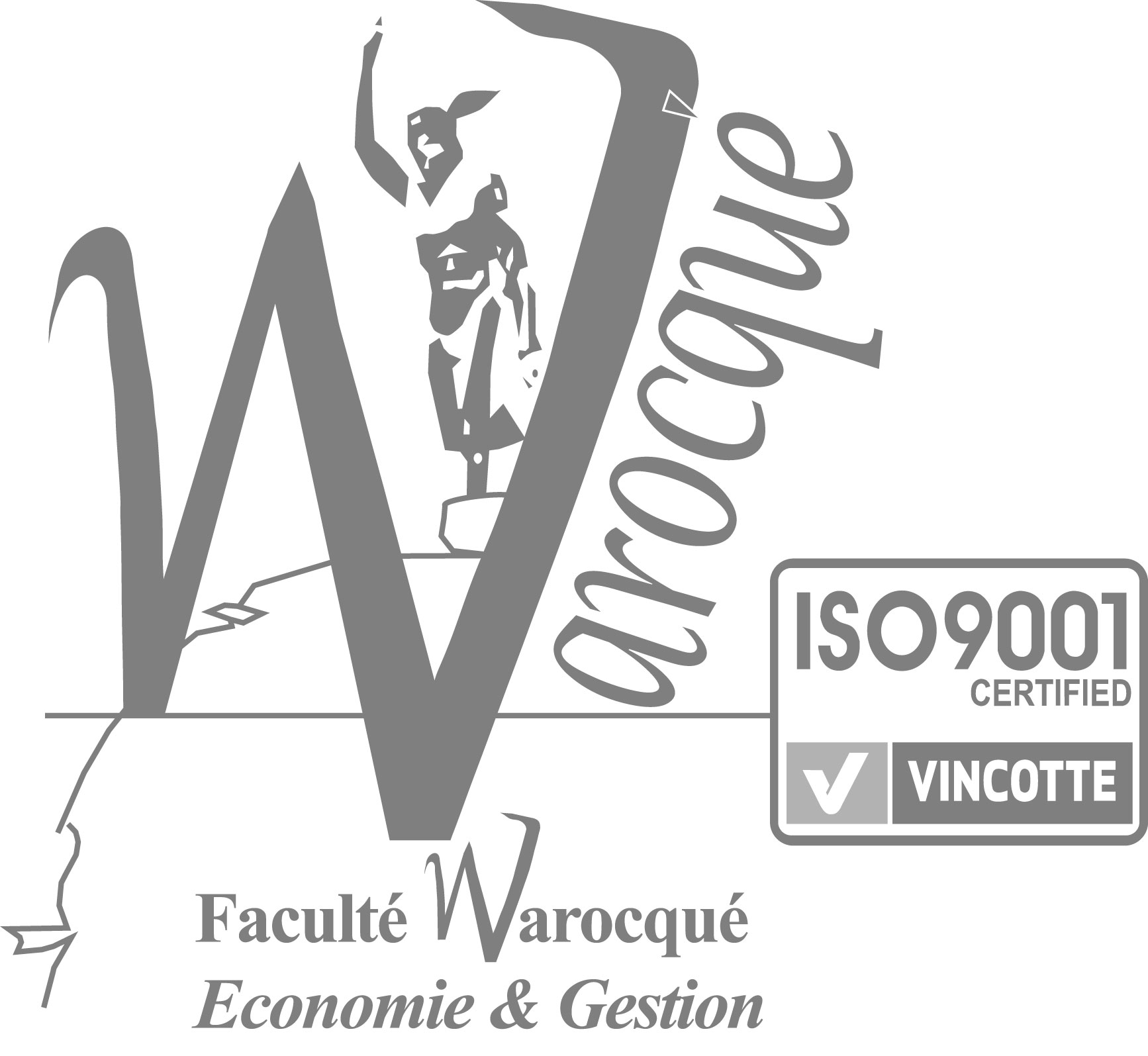 | Study programme 2022-2023 | Français | |
 | Risk Management | ||
Programme component of Master's in Management (CHARLEROI) (shift schedule) à la Warocqué School of Business and Economics |
| Code | Type | Head of UE | Department’s contact details | Teacher(s) |
|---|---|---|---|---|
| UW-M1-SCIGES-021-C | Compulsory UE | BAUWERAERTS Jonathan | W711 - Service de Comptabilité,Audit, Risk management et Entrepreneuriat |
|
| Language of instruction | Language of assessment | HT(*) | HTPE(*) | HTPS(*) | HR(*) | HD(*) | Credits | Weighting | Term |
|---|---|---|---|---|---|---|---|---|---|
| Français | 18 | 12 | 0 | 0 | 0 | 6 | 6.00 | 2nd term |
| AA Code | Teaching Activity (AA) | HT(*) | HTPE(*) | HTPS(*) | HR(*) | HD(*) | Term | Weighting |
|---|---|---|---|---|---|---|---|---|
| W-COGE-047 | Risk Management - AAEP | 12 | 6 | 0 | 0 | 0 | Q2 | |
| W-COGE-048 | Risk Management - AAEHP | 6 | 6 | 0 | 0 | 0 | Q2 |
| Programme component |
|---|
Objectives of Programme's Learning Outcomes
- Mobilise expertise in at least one area of management.
- Mobilise acquired skills in a specific professional environment.
- Contribute to the development of innovative tools and solutions.
- Be independent and regularly adapt to new contexts.
- Demonstrate independence and persevere, despite the difficulties or initial errors, to find an optimal solution.
Learning Outcomes of UE
After completing this teaching unit, students will be able to understand the challenges associated with ERM, to master the implementation and monitoring processes of ERM, to apply and compare the most frequently used ERM frameworks and to contextualize the application of risk management policy.
UE Content: description and pedagogical relevance
The course will focus on the key activities and processes that must be considered for the implementation and monitoring of Enterprise Risk Management (ERM). Some of the most frequently used ERM frameworks (COSO framework, ISO 31000 Risk Management) are presented. Case studies illustrate the concrete functioning of the risk management process within organizations. The course plan is presented below:
Chapter 1: Generalities on Risk Management
1.1. Types of risks, risk management and Enterprise Risk Management (ERM)
1.2. Evolution of risk management
1.3. Drivers of ERM
1.4. The value-added of ERM
1.5. Integrating risks into strategic planning
1.6. Creating a strategic risk mindset and culture
1.7. Building a strategic risk assessment process
1.8. Corporate governance and ERM
1.9. The three lines of defense of risk management
Chapter 2: The components of ERM frameworks
2.1. Mandate and commitment to the ERM framework
2.1.1. Agreement in principle to proceed with ERM
2.1.2. Gap analysis
2.1.3. Context for framework
2.1.4. Design of framework
2.1.5. Implementation plan
2.2. Risk management policy
2.2.1. Policies for the ERM framework
2.2.2. Policies for risk management decisions
2.2.2.1. Risk appetite
2.2.2.2. Risk criteria
2.2.2.3. Internal risk reporting
2.3. Integration of ERM in the organization
2.4. Risk Management Process (RMP)
2.4.1. Context
2.4.2. Risk assessment (identification, analysis, and evaluation)
2.4.3. Risk treatment
2.5. Communications and reporting
2.6. Accountability
2.7. Monitoring, review, and continuous improvement
Chapter 3: EMR tools and techniques
3.1. Key Risk Indicators (KRIs)
3.1.1. Definition
3.1.2. Illustrations of KPIs
3.1.3. Value of KRIs to Risk Management
3.1.4. Applications
3.2. Risk tolerance
3.2.1. Definition
3.2.2. Factors to consider in setting risk tolerance
3.2.3. Applications
3.3. Risk profile
3.3.1. Definition
3.3.2. The risk map/matrix
3.3.3. The heat map
3.3.4. Applications
3.4. Quantitative risk assessment
3.4.1. The two-dimensional risk map
3.4.2. Refined classification of risks
3.4.3. Basic statistical analyses
3.4.4. Total corporate risk
Chapter 4: Application of ERM frameworks
4.1. The COSO framework
4.1.1. Main principles
4.1.3. Evolution
4.1.3. Components
4.1.4. Applications
4.2. The ISO 31000 Risk Management framework
4.2.1. Main principles
4.2.2. Components
4.2.3. Applications
Prior Experience
Not applicable
Type(s) and mode(s) of Q2 UE assessment
- Written examination - Face-to-face
- Production (written work, report, essay, collection, product, etc.) - To be submitted online
Q2 UE Assessment Comments
Presentations and/or works: 20%
Written examination: 80%
Type(s) and mode(s) of Q3 UE assessment
- Written examination - Face-to-face
Q3 UE Assessment Comments
Written examination: 100%
Type of Teaching Activity/Activities
| AA | Type of Teaching Activity/Activities |
|---|---|
| W-COGE-047 |
|
| W-COGE-048 |
|
Mode of delivery
| AA | Mode of delivery |
|---|---|
| W-COGE-047 |
|
| W-COGE-048 |
|
Required Learning Resources/Tools
| AA | Required Learning Resources/Tools |
|---|---|
| W-COGE-047 | Not applicable |
| W-COGE-048 | Not applicable |
Recommended Learning Resources/Tools
| AA | Recommended Learning Resources/Tools |
|---|---|
| W-COGE-047 | Not applicable |
| W-COGE-048 | Not applicable |
Other Recommended Reading
| AA | Other Recommended Reading |
|---|---|
| W-COGE-047 | Not applicable |
| W-COGE-048 | Not applicable |